Motoring had been demonstrated as a practical possibility as early as 1890, but not until 1900 was the motor car a serious challenger in the world of mechanical transport. The period of experiment then gave place to the period of improvement
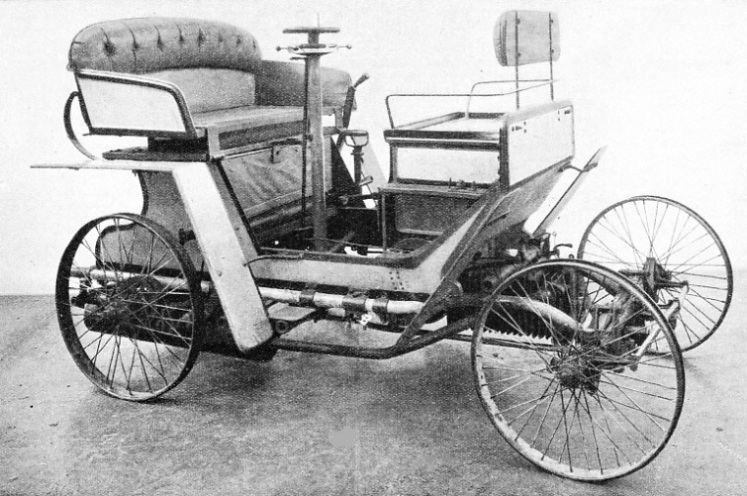
DARRACQ CAR built in 1898. This car had a tubular chassis frame which resembled, in shape, the chassis of many modern cars. The driver and passenger sat facing each other, only the driver’s seat being sprung. Several of the engine controls were grouped at the top of the steering column, thus foreshadowing another feature of the modern car.
EUROPEAN tradition almost invariably credits Benz, Daimler and Maybach with being the real inventors of the motor car, and extends a proportion of gratitude to Butler for his experiments of 1888-89. To a great extent that credit is justified. These men did invent the motor, independently of experimenters in other parts of the world, and almost independently of one another. In the 1890s, however, a bombshell fell on every one concerned with motor pioneering work.
This came from an American inventor, George Selden. He held a patent for a motor car, which he had taken out in 1895. This patent had first been applied, for as far back as 1879. There was no doubt about the early application. Being an astute business man, Selden had deliberately and successfully delayed the filing of the patent for sixteen years, waiting until a real demand for motor cars justified it.
Selden’s design of 1879 contained most of the basic features thought out independently by Benz and Daimler. His engine incorporated the essential features of their engines, his transmission was by gears, and his car was fully equipped with clutch and differential. If the original patent had been taken out at the end of the 1870s, it would have expired too soon to benefit Selden’s pocket. As it was, motoring was beginning to boom when Selden went into action.
Selden found an able ally in George Day, President of the Electrical Vehicle Company, who acquired a controlling interest in the patents on terms exceedingly satisfactory to Selden. Day then enforced the rights of royalties on all cars manufactured in the United States, and good business was done. Although Selden is hailed as the original inventor of the motor car by many Americans, he has probably not received nearly the amount of credit he deserved.
Another American, George Brayton, is said to have produced an engine in 1852 and to have used it on a tramway car in Providence, R.I., in 1872. Samuel Morey, also of America, is reported to have experimented with a form of petrol engine in 1826 and to have driven a boat with it. In 1829 he intended to fit it to a carriage.
All details of these early inventors, however, are extremely vague, whereas the clear-cut development of the motor car may be easily traced from the early work of Benz and Daimler.
By 1890 Benz and Daimler, between them, had shown the world that motoring was a practical possibility, but the cars were still exceedingly crude. By 1900, however, the motor car was a serious challenger in the world of mechanical transport. An 1898 Daimler may look crude and antique at first glance, but when it is compared with an 1890 Daimler it is obvious that the later model provides a direct line of descent to the modern car. The four-cylinder water-cooled engine is placed in front, with a bonnet over it. In front of the bonnet is an orthodox radiator, from which the water is circulated through the cylinder water-jackets by means of a pump. True, there is no “live” axle, the rear wheels being driven by chains. In its general arrangement, however, that old Daimler, built in 1898, is the direct ancestor of the modern car.
Designers during the 1890s produced many different arrangements before that of the Daimler became general, and some weird and wonderful cars appeared on the roads of France, Germany and Great Britain. Moreover, some of them put up astonishingly good performances, considering their period and peculiarities. In 1890 the car was still an experiment; by 1900 there was no doubt that the car had come to stay. The period of experiment had at last given place to the period of improvement. The eighteen-nineties have an additional significance where British motoring is concerned. In 1890 experiment in Great Britain was bound fast by the restrictions of the Highway Act of 1865. Any one who drove any form of locomotive on the British roads — and the lightest motor-cycle is a locomotive, in law — at more than a walking pace, with fewer than three attendants, and without a red flag man walking along in front, became, in the eyes of the law, a combined brigand, potential murderer and dangerous revolutionary A revolutionary he certainly was, and the conventional forces of law and order were against him.
Highway Act Repealed
By 1895 the provisions of the Highway Act were obviously out of date. The pioneer motorist plodded patiently along at a walking pace, with his enforced standard bearer trudging along in front with the red flag. Sometimes the pioneer was not so obedient. T. R. B. Elliot, in Scotland during 1895, used his car in a perfectly normal fashion, and, as he recorded, “the Roxburghshire police undertook not to prosecute — unless a complaint was received from any of the public”. Another pioneer owner-driver was fined one shilling and 15s. 7d. costs by a magistrate at Fareham, Hants. Hostile crowds mobbed motorists and bus drivers tried to push them off the road. Then, in 1896, the repressive Act became a thing of the past.
Among the early motoring engineers who made history between 1890 and 1900 were many who were destined to become famous in after years. There was F. W. Lanchester, who built his first car in 1896. There were the Count de Dion and M. Charles Bouton, who made a spectacular changeover from steam to petrol propulsion. There were Henry (later Sir Henry) Royce and the Hon. C. S. Rolls, who was fated to become an early martyr to the cause of aviation.
Leon Bollee had begun to build steam cars as far back as 1873, and in the late 1880s de Dion, Bouton and Serpollet also built steam cars. All these men turned their attention to the petrol car in after years. French ingenuity was well to the fore after the initial experiments in Germany.
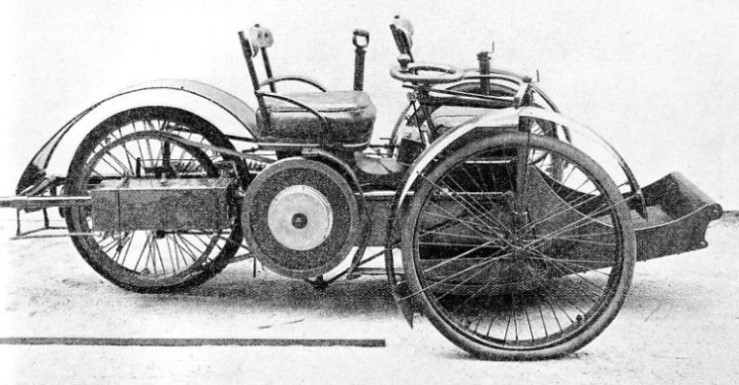
BOLLEE MOTOR TRICYCLE, built in 1896. The rear wheel was mounted on swinging bearings and was driven by a flat belt. The single-cylinder engine was mounted on the left side of the frame and the crankshaft carried three spur wheels of different diameters. In front of this was the shaft which carried the belt pulley, and on this shaft was a sliding sleeve with three more spur wheels. The sleeve was moved laterally to engage one of the three gears.
Daimler’s patents were taken up in France by MM. Panhard and Levassor, and a Daimler car was built by them in 1894. It was driven by a two-cylinder four horse-power water-cooled engine, the cylinder dimensions of which were 2.95 in. diameter and 5.51 in. stroke. The two cylinders drove on the same crankshaft, explosion of the mixture taking place in them alternately. The exhaust valves were operated, through cams, by the crankshaft, and the inlet valves were automatic. A float feed carburettor of the type devised by Maybach in 1893 was fitted, and firing was by tube ignition, as in all previous Daimler cars. The vehicle had a four-speed gear, the maximum speed being slightly over fifteen miles an hour.
The engine was placed in front, on the car’s centre line, as in modern practice, and it engaged with a longitudinal driving shaft through a friction clutch. Above this shaft was another, and this upper shaft operated, through bevel gears, the sprocket wheels, whence motion was imparted to the rear wheels through chains. The rear wheels ran loose on their axle, the chain sprockets being bolted to their spokes. On the countershaft was a band brake, pedal-operated by the driver; a hand lever controlled brake blocks acting on the tyres of the driving wheels. The application of either brake caused the automatic disengagement of the clutch.
The wheels of this Panhard and Levassor car were of wood, and the body was built up of wood and iron, the engine and transmission being supported by an auxiliary iron frame, the whole bolted firmly together. Underneath the frame was a silencer through which the exhaust fumes were discharged into the atmosphere. Though the general arrangement was that of the modern car, the vehicle preserved much of the appearance of Daimler’s first effort. The wheels were those of a small victoria or chaise. It was acquired by the Hon. Evelyn Ellis, one of the keenest British motor pioneers, and was used by him for some time in France. In June 1895 he introduced it to the English roads.
It was in the momentous year of 1894, when Panhard and Levassor built this car (which is now at the Science Museum, South Kensington), that the Count de Dion called a famous conference at his house in France. All the great French motoring pioneers were there, and they decided that in the following year a great road race was to take place between Paris and Bordeaux, in both directions. The distance was 732 miles; so this was indeed an ambitious beginning.
First Great Road Race
The race began at midday on June 11, 1895, the starting point being at Versailles. De Dion-Bouton steamers competed with petrol cars by Peugeot and Panhard and Levassor. De Dion’s steam car took the lead as far as Vouvray on the Loire, where a bad breakdown put a stop to its progress. On its tests it had managed a maximum of 38 miles an hour. M. Levassor was the winner. He drove the famous No. 5, a 4½ horse-power Daimler type Panhard and Levassor car with a Phoenix engine, running on solid rubber tyres. It had three speeds, the maximum being 18½ miles an hour, and the engine running speed was normally 750 revolutions per minute. With this little vehicle, M. Levassor completed the course in 48 hours 48 minutes. Altogether, he was in charge of the car for nearly 53 hours. If it was an endurance test for the car, it was doubly an endurance test for the man. Not a single breakdown overtook M. Levassor, and his only stops were for taking in water and petrol, and for cleaning.
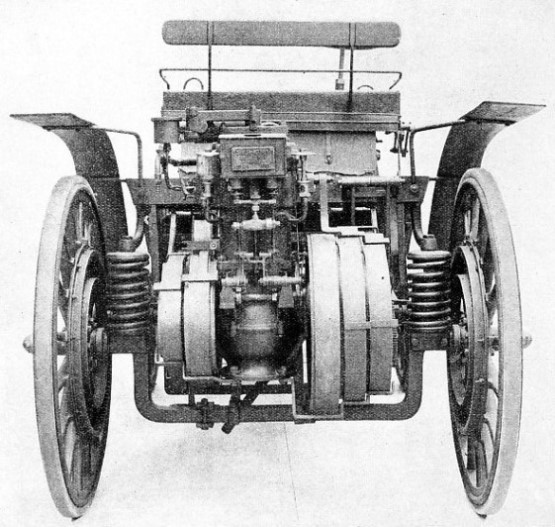 This race demonstrated two things. It showed that long-distance motoring was practicable; it also demonstrated the great efficiency of the often doubted petrol engine. Fifteen petrol cars, six steamers and one electric car started off. There returned eight petrol cars and one steam car, the others having failed to stay the course.
This race demonstrated two things. It showed that long-distance motoring was practicable; it also demonstrated the great efficiency of the often doubted petrol engine. Fifteen petrol cars, six steamers and one electric car started off. There returned eight petrol cars and one steam car, the others having failed to stay the course.
ONE OF THE EARLIEST DAIMLERS, made in the works at Cannstatt, Germany, in 1895. The engine was mounted vertically at the rear, and the body was mounted on the chassis through helical springs. Metal wheels with solid rubber tyres were provided and the final drive was applied to the rear wheels by a countershaft which engaged with gear wheels bolted to the spokes.
Out of the committee convened by de Dion grew the French Automobile Club, the membership of which increased in its first three and a half years from fifty to nearly 2,000. On September 4, 1896, the Club organized a race from Paris to Marseilles and back, the course being 1,077 miles in length. Twenty-nine petrol cars and three steam cars competed. All the petrol-driven cars returned to their starting point; the three steamers were the only casualties. One of these, a de Dion-Bouton, fell out at the beginning. De Dion and Bouton, however, also entered their new type of petrol-driven three-wheeler, which won unexpected success. A four-stroke, air-cooled engine of about 2½ horsepower was used, with electric ignition, current being supplied by a dry battery. The carburettor was of the surface type, and the machine was started by pedals and chains, a cock in the cylinder head being opened on starting to relieve compression in the cylinder. The vehicle was a motor-cycle rather than a car.
The winner of the Paris-Marseilles-Paris race of September 1896 was once again a Panhard and Levassor car, No. 6, driven by M. Mayade. It was an 8 horse-power car with a four-cylinder engine. The average speed was 15.9 miles an hour, the maximum average over a single stage being about eighteen miles an hour. After the success of the De Dion-Bouton three-wheelers in the Paris-Marseilles run, three-wheeled cars enjoyed considerable popularity. L. and A. Bollee, in 1896, produced a tandem three-wheeler, with a single horizontal air-cooled cylinder driving on to the rear wheel by a belt. This engine developed a nominal output of 3 horse-power. The car had three speed gears and was, for its date, a remarkably light and efficient little vehicle. Its three 2 ft. 4 in. wheels were fitted with pneumatic tyres, its wheelbase was only 4 feet and its track width 3 ft. 6 in. It weighed 3¼ cwt.
Enterprise in Great Britain
About this time, Roots and Venables set to work in England to produce a car which could run on heavier oil such as paraffin. Roots had patented a suitable engine in 1891 and 1892, and the car appeared in 1895. It was a three-wheeler with a slow-speed vertical engine rated at 2½ horse-power and having a four-stroke cycle. The fuel mixture was formed in a heated chamber when it was admitted to the cylinder through a valve operated by an eccentric on the crankshaft. The same valve admitted oil to the heating burner of the tube ignition system. A friction clutch transmitted the power from the crankshaft to the sprockets of the chain drive, a differential and an epicyclic gear being mounted on the rear axle.
The single wheel was in front and served to guide the car, steering being accomplished by means of the old-fashioned and sometimes uncontrollable tiller. At a normal engine speed of 500 revolutions a minute, the car’s two-speed gears gave it maximum running speeds of five and thirteen miles an hour in bottom and top.
The efforts of the Hon. Evelyn Ellis, Sir David Salomons, the Hon. C. S. Rolls and others, all of whom defied the obsolete law by driving without red flags before 1896, did much to further the cause of motoring in England, and T. R. B. Elliot did similar work in Scotland. Though French and German cars still predominated, well-known British names — Napier, Lanchester, Wolseley, Enfield and Ariel — begin to creep into the records during the late 1890s. British inventiveness and British enterprise were getting to work and reviving the tradition originated by Butler in the 1880s.
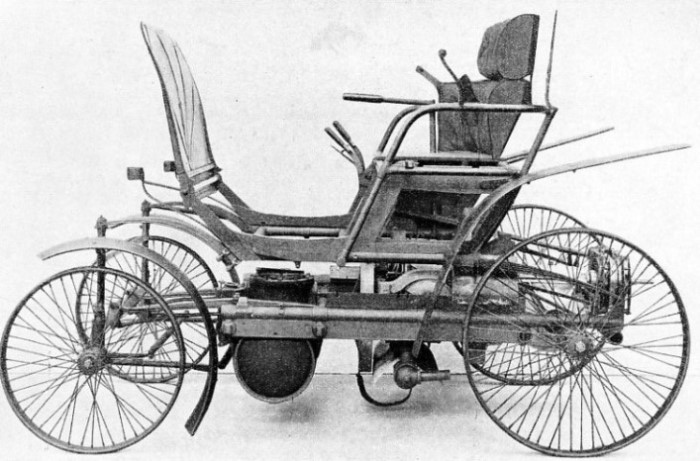
TWO-SEATER PHAETON WITH AN 8 HORSE-POWER ENGINE—the 1897 Lanchester car. This was one of the first cars in which magneto ignition was successfully used. The engine had two air-cooled cylinders and transmitted its power to the rear wheels through a longitudinal shaft and worm gear. Pneumatic tyres, rapidly gaining favour at the time, were used on this car.
F. W. Lanchester designed and built his first car during 1895 and 1896, and two-seaters of his design were on the market by the following year. He made the phaeton his prototype and placed the engine underneath the seat and between the frames. This was one of the first really successful cars with magneto ignition. The ignition was on the low-tension system. The engine had two 5 in. by 2½ in. horizontally-opposed air-cooled cylinders and developed 8 horse-power at 700 revolutions a minute. Almost perfectly balanced, this engine transmitted its power through a longitudinal shaft and a worm gear to the back wheels, which had a diameter of 3 feet. The wheels were of the wire spoke type with pneumatic tyres, which, in spite of all their early drawbacks — the result of inexperience — were rapidly growing in favour. Two forward speeds and one reverse were given by an epicyclic gear. This first Lanchester car had a wheelbase of 5 ft. 10 in., and a track gauge of 3 ft. 10 in. It is now preserved in the Science Museum, South Kensington.
An excellent example of a really modern car, judged by the standards prevailing at the end of the 1890s, is the 1898 Daimler mentioned at the beginning of this chapter. It was the first car to be built by the still famous British Daimler Company at Coventry. Its four water-cooled cylinders, of 3.54 in. diameter and 4.72 in. stroke, were cast in pairs. The power output of the engine at 700 revolutions a minute was 12 horse-power; ignition was by a Simms-Bosch low-tension magneto. The exhaust valves were cam-operated and the inlet valves automatic. The carburettor was of the spray type, and the petrol tank was mounted on the inside of the dashboard.
1,377 Miles at 30.8 Miles an Hour
The steering-gear was of the type familiar to us to-day, though at that time most motorists were used to the primitive tiller. The wheels, however, were of wood, with solid rubber tyres. Braking was by means of blocks applied to a drum on the transverse driving shaft, the brake being applied by a pedal beside the driver’s seat. In addition to this, there were hand brakes acting on the tyres of the rear wheels, as in earlier designs.
Both axles in the 1898 Daimler were equipped with semi-elliptic springs, and the driving wheels, of 38 in. Diameter, were 10 in. larger than the leading wheels. The wheelbase was 6 ft. 7 in., and the wheels were set to a gauge of 4 ft. 8 in. This car was built for Lord Montagu of Beaulieu, another great pioneer of British motoring, and achieved honours in the Paris to Ostend race of 1899. There were many important road races during the close of the critical 1890s.
The Paris-Dieppe race took place on July 24, 1897, and was won by a 3 horse-power Bollee, which covered the distance of 106 miles in 4 hours 13 minutes, at an average of 25.3 miles an hour. In July 1898 an 8 horse-power Panhard covered the 901½ miles from Paris to Amsterdam and back at an average speed of 27.3 miles an hour. In 1899 a grand “Tour de France” was organized, over a route of 1,377 miles. For this, Panhard and Levassor had ready a 16 horse-power car, which, driven by de Knyff, covered the course in 44 hours 39 minutes, or at an average speed of 30.8 miles an hour. Not only speed but also efficiency and endurance were beginning to tell. It could no longer be said that the motor car had no staying power.
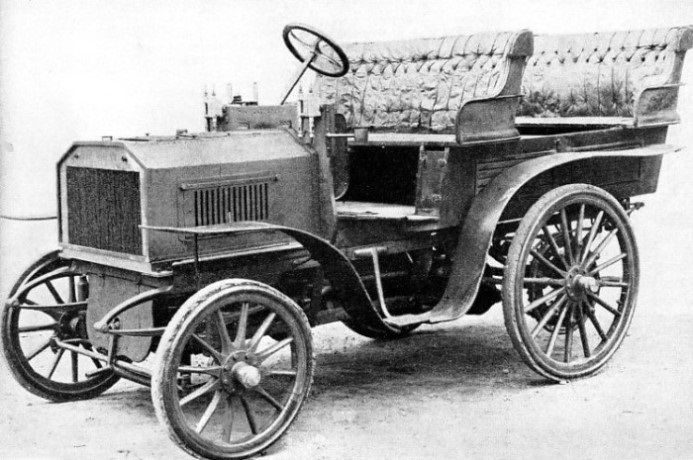
MODERN IN APPEARANCE, by comparison with its predecessors, the 1898 British Daimler included many features that were years ahead of their time. Both axles were equipped with semi-elliptic springs, and the radiator and bonnet set a fashion which was followed by many manufacturers. This car was built for the late Lord Montagu of Beaulieu, a great pioneer of British motoring. It was rated at 12 horse-power.
You can read more on “Garage Equipment”, “Romance of Motor Car Making” and “The Work of Benz and Daimler” on this website.







 This race demonstrated two things. It showed that long-
This race demonstrated two things. It showed that long-
